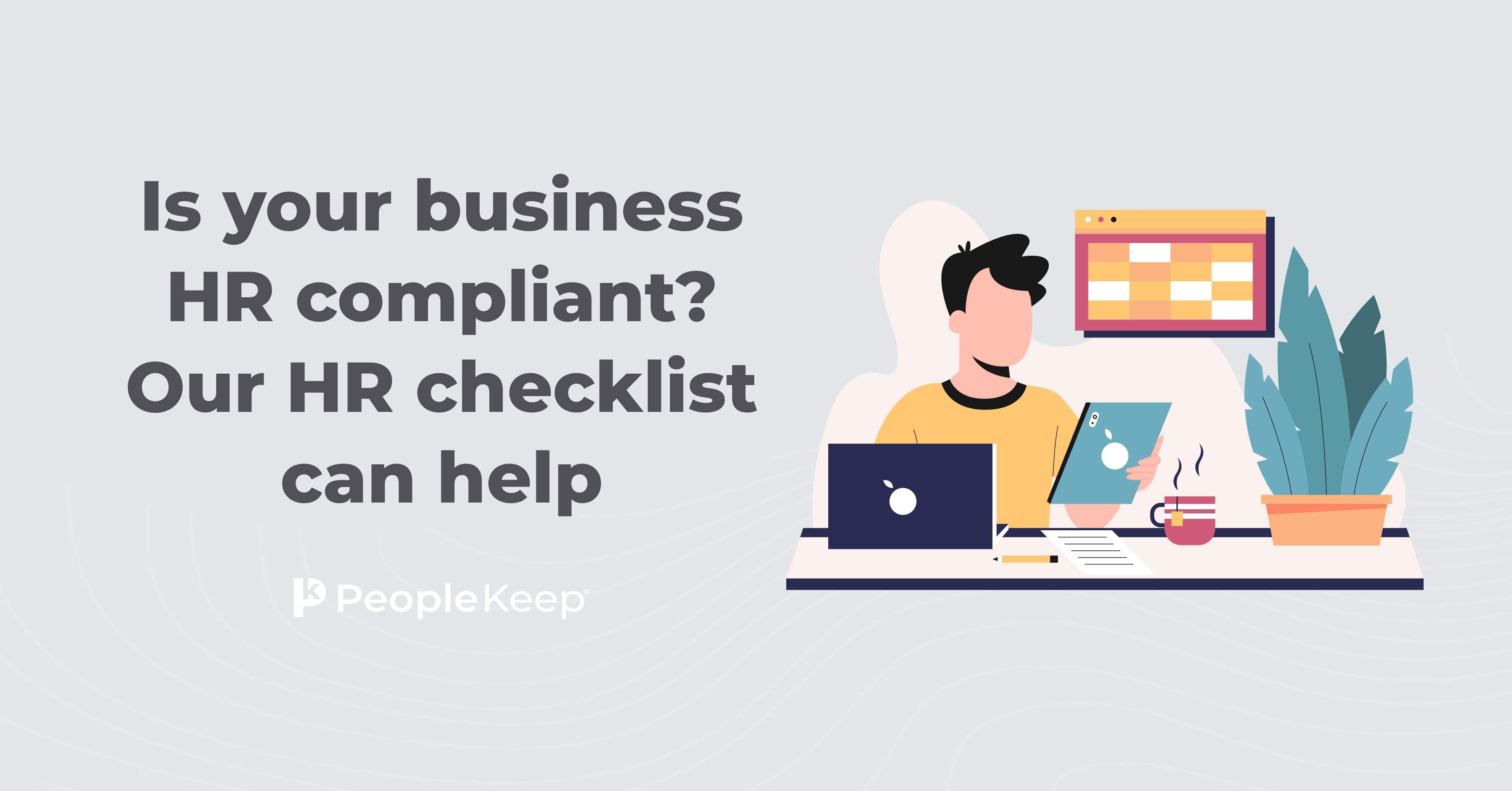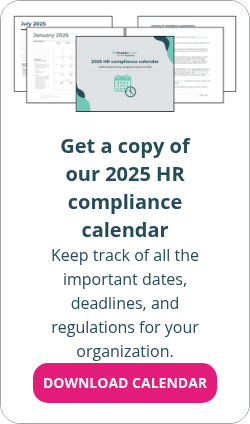Common HR mistakes and how to avoid them
By Chase Charaba on August 29, 2023 at 2:01 PM
From managing employee safety to handling employee engagement and benefits, your human resources department plays an essential role in managing your company’s most valuable asset—its people.
With all of the responsibilities this brings, HR departments often face challenges and are at risk of making errors that can lead to compliance issues and costly consequences. In today's competitive labor market, it's essential for HR professionals to stay updated with best practices to prevent putting a business at risk.
In this article, we'll discuss some common HR mistakes and provide tips on how to avoid them.
Lack of company policies and procedures
One of the most important things a business can do is create comprehensive company policies and procedures that explain how to handle workplace situations and duties. Without clear company policies, your employees won't know what's expected.
Policies need to address any possible areas of confusion for employees. This could include rules around cell phone use, a code of conduct (including sexual harassment policies), and anything else legally required, such as wage information and anti-discrimination policies.
Be sure to provide any policies to employees, which you can do in the form of an employee handbook or by displaying posters around the workplace. You can use the U.S. Department of Labor's Basic Compliance Toolkit1 to keep policies up-to-date with federal regulations.
Poor hiring practices
One of the most common HR mistakes is poor hiring practices. Hiring the wrong person can result in decreased productivity, increased turnover, and poor team dynamics. To avoid this mistake, HR professionals should establish a clear and thorough hiring process. This includes drafting detailed job descriptions, conducting comprehensive interviews, checking references, and utilizing pre-employment assessments to gauge a candidate's skills and cultural fit.
Inadequate onboarding and offboarding processes
Some organizations don't focus enough on the onboarding process once a candidate is selected. A smooth onboarding process is vital for your new employee’s success. Otherwise, they may leave due to stress or a lack of direction.
A good employee onboarding process should introduce your new hires to the organization. It should include opportunities to learn about company values, culture, policies, and the organization’s overall mission. You'll also want to provide your new hires with all the tools they need to get started. This is also the time to inform them of their employee benefits (more on those later).
Be sure to introduce new employees to their co-workers and show them around. You want them to feel comfortable and ready to get to work.
You'll also need to set and organize procedures for offboarding employees. Otherwise, you'll likely forget to do something, such as removing their company email access. Creating an offboarding checklist is a great place to start.
Lack of communication
Poor communication is another major mistake that can lead to misunderstandings, conflicts, and decreased employee morale. HR professionals should prioritize effective communication by ensuring they share information promptly and clearly. This includes regular updates about company policies and changes and providing opportunities for feedback.
To encourage open communication at your organization, implement an open-door policy. This promotes a culture where employees feel at ease approaching management for assistance and inquiries.
Mishandling employee records
Not keeping employee records is another common mistake.
Keeping your organization's employee records organized is paramount. Maintaining complete records will help your organization show that its hiring process is fair and that any staff reductions are justified if potential issues arise. You'll need these records to protect your organization against disgruntled employees and potential litigation.
You need to keep all hiring records, employee performance reviews, resumes, drug test results, attendance, payroll, and other additional forms.
According to federal law, you must keep an employee's Form I-9 for at least one year after their termination or three years after their hire date. The Department of Labor also recommends businesses keep their payroll records for at least three years.
Keep in mind that the documents mentioned above do not represent a comprehensive list of the records you'll need to hold onto. Check with federal and state laws to ensure that your business is compliant.
Inconsistent data security
Organizations of all sizes are at risk of digital theft and data breaches. For larger organizations, ransomware can be a real threat. You need to protect your organization against cybercrime.
One of the biggest mistakes some businesses make is not training their employees on best practices for data security. This training should include protecting company data, making a strong password, and identifying phishing emails and dangerous websites.
Organizations also need to ensure that their equipment is secure from hackers and viruses. Anti-virus software is a must for organizations that deal with sensitive information.
Finally, to protect against ransomware, be sure to back up all your important files and information. That way, if someone holds your data hostage, you can work off of your company backup without having to spend thousands or millions of dollars getting your data back.
Health benefit mistakes
One of the most common employee benefits is a health benefit. However, not every employer offers a health benefit, and those that do may wonder if they’ve selected the right option that will help them comply with current regulations.
Health insurance mistakes
One of the most costly mistakes organizations make is paying for individual employee health insurance premiums directly. If you pay for your employees' health insurance premiums directly, the IRS considers this an employer payment plan (EPP).
Since EPPs don't comply with the Affordable Care Act’s requirements, they aren't compliant with the current IRS code2.
Failure to comply with these regulations can result in a $36,500 fine per worker.
Organizations can, however, reimburse employees for healthcare expenses with a health reimbursement arrangement (HRA). Employers can also give employees a health stipend if they don't require employees to purchase health insurance.
Another health insurance mistake is offering your group health insurance plan to an independent contractor. While there's nothing wrong with doing this, it can be tricky to navigate health benefits for 1099 employees. You'll want to ensure that any benefits provided to a contractor are considered taxable income.
Health insurance reimbursement mistakes
In lieu of group health coverage, many businesses opt to provide their employees with a health insurance reimbursement. This can take the form of a health stipend or an HRA.
If you choose to provide a health stipend to your employees, you can't ask them to provide proof of health insurance, as the IRS considers this an EPP. You also can't ask for receipts or proof of expenses for certain expenses listed in IRS Publication 502 when an employee requests a reimbursement.
If you want to require proof of insurance and receipts for healthcare expenses, you should consider offering your employees an HRA instead.
HRAs are formal health benefits established by the federal government that allow you to reimburse your employees for their health insurance premiums or out-of-pocket expenses. They're tax-free for employers and employees, making them a great option for most organizations.
HIPAA violations
Another common employee benefit mistake is violating HIPAA guidelines. The HIPAA Privacy Rule governs group health benefits, HRAs, and more. Established in 1996, HIPAA helps keep protected health information (PHI) safe. This includes names, Social Security numbers, medical records, and more.
Healthcare providers, insurers, and employers are subject to the HIPAA Privacy Rule if they deal with PHI. Under the rule, employers can't use or disclose PHI except as permitted or if the individual authorizes the use of their PHI in writing.
Unfortunately, HIPAA violations are common. There are many ways for PHI to end up being accidentally disclosed. This can result in stiff penalties with fines ranging from $100 to $50,000 per violation for organizations.
To protect your employees, you must keep their PHI safe. Your organization should adopt a written PHI privacy procedure that all employees must follow. You should also train employees who handle PHI to ensure you meet HIPAA requirements.
There's an easier way to ensure that your organization remains HIPAA compliant with health insurance reimbursements. Contracting with a third-party processor to review all claims and reimbursement requests is a great way to ensure that your organization never comes in regular contact with your employees' PHI.
How to ensure your health benefit remains compliant
One way to ensure that your health benefit is compliant is to use a third-party benefit administration software such as PeopleKeep. With our HRA platform, you can offer HRAs to your employees with ease.
With benefit administration software, you have the support you need to keep up to date on regulations. Our professional documentation reviewers can look over HRA reimbursement requests and documents for you to remain HIPAA compliant.
Other employee benefit mistakes
Employee benefit mistakes can be costly to employers. In addition to the health benefit mistakes above, there are many other opportunities for error that can spell disaster for your organization.
If your organization deposits funds into a retirement plan, you'll need to do so before the 15th of each month. Otherwise, the IRS could fine your organization. However, small businesses can deposit these funds within seven days of the employees' payday.
Another human resource mistake involving retirement benefits is not calculating matching contributions correctly. Be sure to double-check that you're depositing the correct amount each month.
Additionally, all employee benefit plans under ERISA must have a summary plan description available to all employees. Failure to provide a plan document to an employee within 30 days can result in fines of up to $110 per day.
Conclusion
Avoiding costly HR mistakes is crucial for the success of any organization. If your organization has made any of these common errors, you'll want to take immediate action to rectify them. Otherwise, your organization could be faced with stiff fines or other costly consequences. Be sure to check with your state and local governments for additional laws and regulations that your organization needs to follow to remain compliant.
Want help offering a compliant HRA? Schedule a call now with a personalized benefits advisor!
This blog article was originally published on March 8, 2017. It was last updated on August 29, 2023.
Check out more resources
See these related articles

What is human resource management (HRM)?
Human resources management is the strategic approach to managing an organization's workforce. Learn more about what HR entails in this comprehensive guide.

How to plan an HR budget
Planning an HR budget can be challenging, but with the right strategies, it can be made easier. Learn how to plan an HR budget with this comprehensive guide!

Is your business HR compliant? Our HR checklist can help
Is your business HR compliant? Our easy-to-use HR checklist will help you assess and improve your HR processes. Stay compliant and protect your business today.



